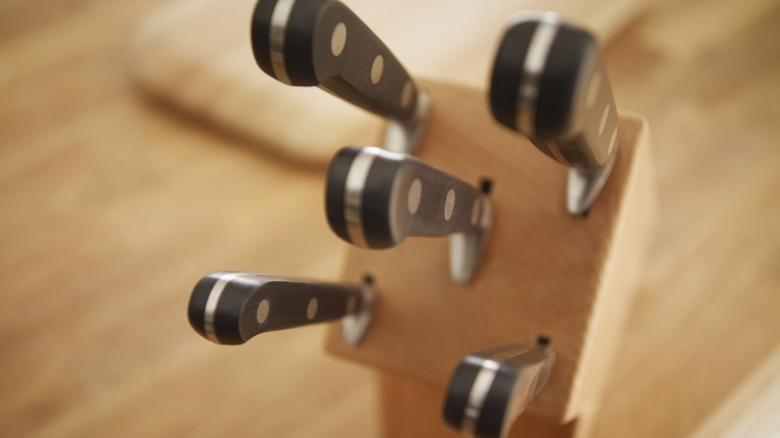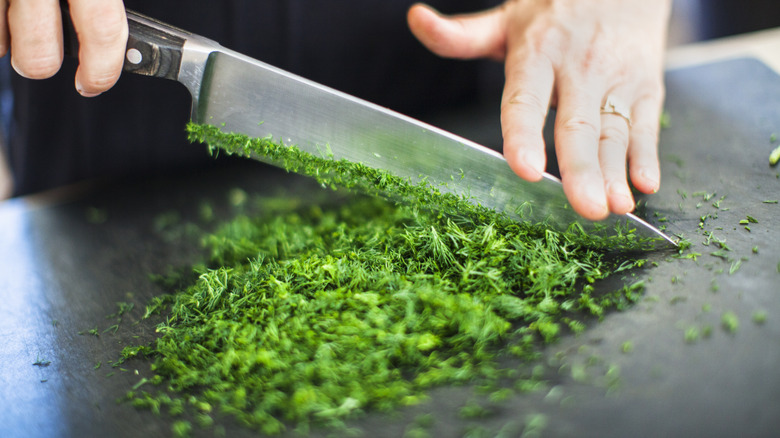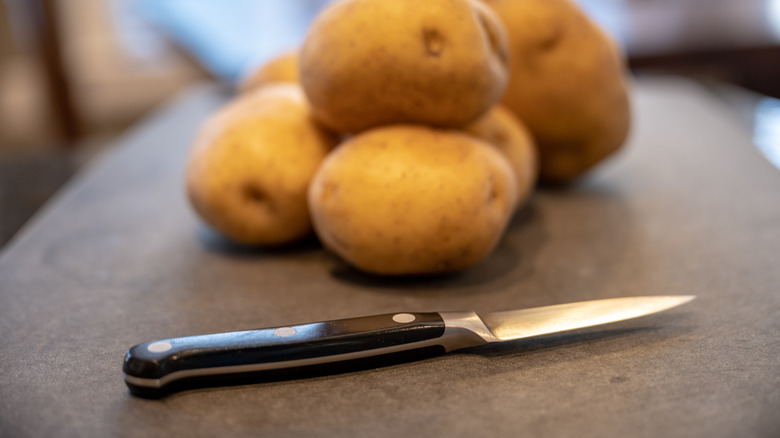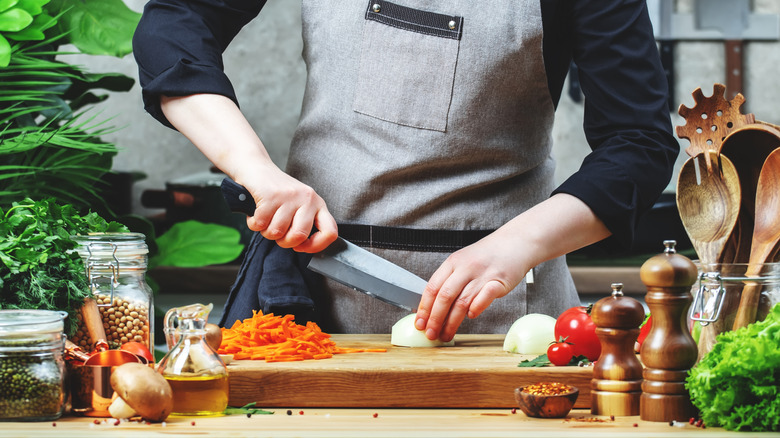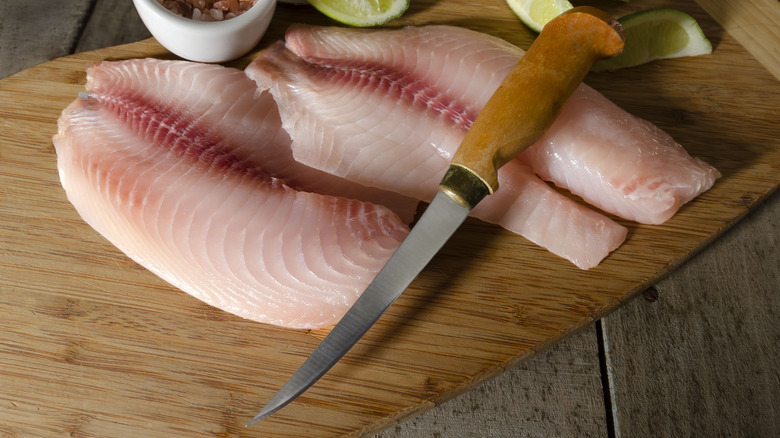5 Crucial Knives To Have In Your Kitchen (And How To Use Them)
We may receive a commission on purchases made from links.
Okay, I'll admit that you don't actually need 16 different kinds of knives in your kitchen, although I'm sure I have many more than that. While I'm personally more of a maximalist than a minimalist, I know I have more knives than I need. So, assuming you're just starting out with a brand-new kitchen bare of the essentials, what knives do you really need for your meal prep?
You may be surprised to learn that you can get by with no more than three knives (although we also recommend having two others as well). These five basic knives form the basis of just about every kitchen. Happily, you do not need Gordon Ramsay's salary to cover the cost of buying these essential knives. Around $50.00 will allow you to pick up all three basic starter knives, while you can round out the collection for about $60.00 more. Of course, you could always borrow one of the approximately 70,000 knives that I've crammed into my utensil drawer.
Bread knife
The bread knife's function is right there in its name, although it is also known as a serrated knife (which describes its sawtooth blade). These types of knives are on the long and skinny side with blades typically ranging from 7 to 10 inches long, although some may be as long as 18 inches. If you do need to slice a loaf of bread, a serrated knife is the only knife that will do the job right. With a gentle sawing motion, and minimal downward pressure, your bread should fall into neat, even slices. These knives can also be used to easily slice cakes or pastries, protecting their texture. You can even use a bread knife to carve your Thanksgiving turkey and other large cuts of cooked meat. (Many steak knives, too, have serrated blades, although these are, of course, much smaller than bread knives.)
The main drawback to bread knives is that they are a pain to sharpen. Unfortunately, there's really no way around this. You need a serrated knife, so you'll just have to learn how to sharpen it. It's either that or you buy a new bread knife every time the blade becomes dull, but that option is a bit too expensive (and wasteful) for most of us.
Speaking of bread knife buying, the Orblue 10-inch Serrated Bread Knife is a great choice. The blade is sharp and heavy and produces a nice smooth cut. As a bonus, it also comes in a variety of colors including black, blue, green, orange, red, and silver.
Purchase the Orblue 10-inch Serrated Bread Knife from Amazon for less than $15.00.
Chef's knife
The chef's knife may be the most important knife on this list, or at least the one that you'll use the most on a daily basis. You'll use it for chopping vegetables and meat, for mincing herbs and garlic, and for slicing fruit. The standard French-style chef's knife has a blade ranging between 6 and 14 inches long, but 8 to 10 inches is the most typical length. It is broad in the middle (at least 1 ½ inches at its widest), slightly curved on the bottom, and tapers down to a point at the end. When you use your chef's knife, the tip of the knife stays put on the cutting surface, while you move the rest of the blade up and down, feeding in the item that's being chopped using your other hand.
If you're an actual chef, you may well spend hundreds of dollars on a single knife, and the thought of a knife costing under $30 probably causes you alarm. However, over 1,000 home cooks feel that the Tramontina 8-inch chef knife does an excellent job as a kitchen utility tool even at this budget price. Tramontina is a well-respected Brazilian brand, and this knife's rave reviews come from all over the world (including Japan, where they know a thing or two about knives).
Purchase the Tramontina Pro Series Forged 8-inch Chef Knife from Amazon for $27.61.
Paring knife
Rounding out the trio of essential kitchen knives is the paring knife. This is a somewhat misleading name since you can do a lot more with it than just peel produce. Some have compared it to a miniature chef's knife, and with its 3-½-inch blade, it is much smaller than a traditional chef's knife. This is the paring knife's main strength; its small size means it is great for dealing with fiddly tasks like removing the eyes on a potato or the stems of strawberries. It can also be used to devein shrimp, make radish roses, and slice a single clove of garlic. You can, of course, also use it to remove the skin from an apple or potato, in which case you'll hold the produce in one hand and the knife in the other. Scrape the peel off the item by drawing the knife blade towards your body, being careful not to let it slip. You'll need to keep all five fingers wrapped around the paring knife handle to have the best control.
Rada Cutlery makes a cast aluminum paring knife that's surprisingly elegant considering it costs under $10. (Paring knives tend to be among the less expensive knives.) It's also sharp, sturdy, and holds an edge like nobody's business.
Purchase the Rada Cutlery Heavy Duty Paring Knife from Amazon for $9.00.
Santoku knife
If you have a decent chef's knife, you don't actually need a santoku knife since it's essentially the Japanese version of a chef's knife. While you use them the same way for the same type of jobs, we've chosen to include both in the interest of promoting freedom of choice. One thing that's a bit different about a santoku knife is that it tends to have a shorter blade, only 5 to 7 inches long. The bottom edge is also straighter. This means that the chopping action when using a santoku knife is more vertical than the rolling motion associated with Western chef's knives. Santoku knives also tend to be a little lighter. While the best way to determine whether you prefer a santoku to a Western chef's knife is to use them both, kitchen stores typically don't allow you to test the knives. This means that, if you haven't had the chance to compare, go ahead and pick whichever one appeals to you.
One serious santoku knife that won't set you back too much is the Mercer M20707 Genesis. This 7-inch knife is made of high-carbon German steel and has a sharp edge that lasts a long time. When it does inevitably dull, it's fairly easy to sharpen. What's more, it's priced under $40 but Amazon reviewers say it does just as good a job as knives costing double or even triple that price.
Purchase the Mercer M20707 Genesis 7-inch Santoku Knife from Amazon for around $36.00.
Boning or fillet knife
A boning or fillet knife is not an absolute essential if you don't prepare a lot of meat or fish or generally stick to boneless cuts. If you ever want to de-bone a chicken breast or fillet a whole fish, though, you'll be glad to have one of these knives in your drawer. Boning knives have a thin blade that is typically 5 to 7 inches long. (A fillet knife's blade may be longer if it's meant for larger fish.) The blade, which curves slightly up to a sharp point, may be flexible — in fact, in the case of a fillet knife, it most definitely will be. Fillet knives and boning knives are largely interchangeable, but the fillet knife is meant to be used with fish and that flexibility is necessary in order to allow the blade to slip under the skin and follow all the irregular contours of a fish's body. To use either knife, you can grasp the entire handle with all five fingers or, for more precise control, use your thumb and forefinger to pinch the base of the blade.
For greater versatility, a flexible-blade boning knife should probably be your first purchase in this category since it can be used for both meat and fish. One of the top-rated boning knives on Amazon is made by Victorinox. The Fibrox Pro curved boning knife has a 6-inch blade and a slip-resistant handle (always a good thing). It also boasts a finger guard for further protection.
Purchase the Victorinox Swiss Army Fibrox Pro Curved Boning Knife on Amazon for around $22.00.
